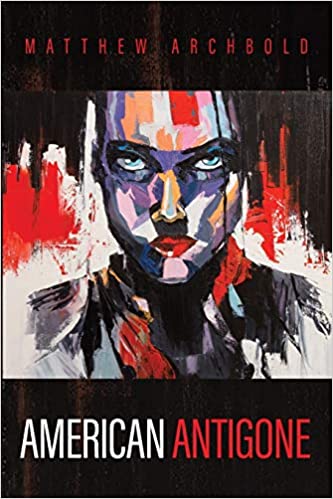This comes from the pen of pro-life activist Dr. Jeff Koloze. This brings “American Antigone” up to 32 reviews. It’s got a 5 star rating. Thank you to all who have read it.
5.0 out of 5 stars Wicked humor, credible characters, fast pace: all the elements needed for today’s abortion fiction.
Directors looking for solid material for their next film should consider bringing Matthew Archbold’s novel to the big screen. This 175-page novel makes compelling reading on a controversial topic that will appeal to readers and filmgoers.
Faculty and students of literature will appreciate the novel for its obvious connection with the ancient Greek drama, Antigone by Sophocles. The comparisons between the ancient Greek drama and the actions developed in twenty-first century America are not restricted merely to the names of the characters and places. For example, Anne Prince is the modern equivalent of Antigone, a princess in the ancient drama; the name of Anne’s sister Izzy is an abbreviation of Ismene, Antigone’s sister; and the action of the novel occurs in Thebes County, Pennsylvania, the modern equivalent of the ancient Greek city-state Thebes.
Much more importantly, the novel parallels the plot of the ancient Greek drama. Sophocles’ drama develops the consequences of Antigone’s actions to provide a proper burial for her dead brother, and Archbold’s novel develops the consequences of Anne’s actions to provide a proper burial for her dead brother.
The major difference between Antigone’s brother and Anne’s is that one was born, the other unborn.
Thus, a 2,400-year-old ancient Greek drama is revised to depict the most significant moral problem in American culture—not racism, not illegal aliens flooding the border, but abortion and the status of the unborn child.
Obviously, people who support abortion—which is legal throughout the nine months of pregnancy for any reason whatsoever, and which harms mothers, kills unborn babies, and alienates fathers—would find themselves in excruciating cognitive dissonance to resolve the moral problem this novel poses.
But that’s all right. After all, fiction is meant not only to entertain, but also to teach.
Except for the clearly positive characters who live by moral standards, other characters, those who do not live by high moral standards, make uncomfortable reading, but the reader will be delighted in seeing these fictional persons. It helps to read about hypocrites before engaging with them in the real world.
For example, the Catholic bishop who seems to oppose Anne’s effort to bury the aborted child is reprehensible for his lack of support for an obviously pro-life woman and for threatening the priest who has befriended Anne. Anne’s Uncle Milton Prince, the newly-appointed prosecutor for Thebes County, is just as reprehensible.
However, readers understand quickly that both of these men operate not on high moral standards as Anne does, but on the basest of utilitarian ethics. Both Catholic bishop and prosecutor live by “the ends justify the means” principle. For the bishop, abandoning Anne when she most needs Church support will save valuable resources for other Catholic charities. For the prosecutor, putting his own niece in jail will show voters that he’s not soft on crime, and getting elected is paramount because only then can he work what he believes are his social justice wonders. Like his campaign adviser, what’s important is not living according to moral standards, but paying attention to public relations: “the main thing is the visual of the police dragging this bitch out” of the church where she sought sanctuary (95).
Meanwhile, ordinary characters are attacked by Antifa-like domestic terrorists, who try to stop Anne’s effort to bury her aborted brother with screams, physical violence, and near-murderous actions. The police seem powerless to protect the good guys. Archbold illustrates cogently and simply how ordinary pro-life people suffer at the hands of those (whether an abortion clinic director, a Catholic bishop, or a power-hungry prosecutor) who believe in sheer power.
The novel is not all political machinations and serious legal action. Archbold’s humor is brutally wicked.
For example, the humor with which Archbold treats the press conference that Uncle Milton barely survives (chapter 26, 88ff) is a horrible trauma for him, but a series of laughs for readers who like to see politicians squirm in hostile press conferences.
Similarly, Archbold’s description of Todd Dooley, an Antifa-like pro-abortion activist who lives in his parents’ basement, is brutally funny (chapter 30, 101ff). The online dialogue that Todd has with other domestic terrorists who want to attack pro-life protesters could have been written as a serious commentary about the ferocity of hateful pro-abortion people. Instead, Archbold makes us laugh at such feeble adults, more concerned about whether their messages should be contained on another portion of the online message board instead of the general thread. Throw in comments about sexism, and readers will laugh at these ridiculous people.
Archbold’s work, in summary, both as a novel and as a future film, has something for everybody. Serious readers who like to read about the resolution of moral problems in a fictional context will enjoy the problems created by a woman who wants to bury her aborted brother’s body while American law decrees that that body is not a human being worthy of such respect.
The relationship between the newspaper reporter Paul, who seems to be concerned only with getting the scoop, and Izzy adds romance to the novel and will enable the eventual film version to be labelled a “chick flick.”
Faculty and students would appreciate this novel for its contemporary adaptation of an ancient controversial dilemma. Faculty should consider immediately adding this eminently readable 175-page novel to their course lists.
The rest of us ordinary readers can delight in a well-crafted, swiftly-moving plot whose characters make us think long after the reading is finished.”
You can purchase “American Antigone” by clicking here.


Leave a Reply